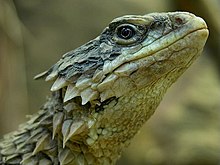Giant girdled lizard
| Sungazer | |
|---|---|
 |
|
| Smaug giganteus | |
| Scientific classification | |
| Kingdom: | Animalia |
| Phylum: | Chordata |
| Class: | Reptilia |
| Order: | Squamata |
| Family: | Cordylidae |
| Genus: | Smaug |
| Species: | S. giganteus |
| Binomial name | |
|
Smaug giganteus (Smith, 1844) |
|
| Synonyms | |
|
Cordylus giganteus |
|
Cordylus giganteus
The sungazer (Smaug giganteus, syn. Cordylus giganteus), also known as the giant girdled lizard or giant dragon lizard or giant zonure, is the largest species of the Cordylidae, a family of lizards from Sub-Saharan Africa. This threatened species is endemic to Highveld grasslands in the interior of South Africa. In 2011, it was assigned to the new genus Smaug along with seven other species previously belonging to the genus Cordylus, based on a comprehensive molecular phylogeny of the Cordylidae.
The sungazer is a heavily armoured species, with a typical snout–to-vent length of 15–18 cm (5.9–7.1 in) (exceptionally up to 20.5 cm or 8.1 in), and is easily distinguishable from other cordylids by the elongated pair of occipital spines and the enlarged keeled caudal spines.
The species is known as the sungazer because of its distinctive thermoregulatory behaviour of elevating the anterior parts of the body by extending its forearms, usually near the entrance of its burrow as if looking at the sun. The species is well known throughout its distribution, and goes by several different common names, in different languages. The most common local name is ‘Ouvolk’, given by Afrikaans landowners who liken the thermoregulatory basking position of the species to retired farmworkers, who spend much of their days sitting in the sunlight. The sungazer is also known ubiquitously as ‘Pathakalle’ by Sotho speaking people and ‘Mbedla’ by Zulu speaking people.
Unlike most other rupicolous (living among rocks) members of the Cordylidae, sungazers live in self-excavated burrows (typically 0.4 m or 1.3 ft deep, and 1.8 m or 6 ft long) in the silty soil of the Themeda grassland in South Africa. They are insectivores, but occasionally will eat small vertebrates. These colonial, ovoviviparous lizards reproduce every two to three years, and only produce one or two offspring per breeding cycle. They are long-lived and captives have been recorded surpassing 20 years of age.
...
Wikipedia

